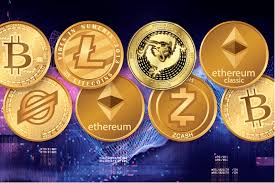Ten types of cryptocurrencies
- Bitcoin
Bitcoin, born in 2008, was the first cryptocurrency and is still the best-known cryptocurrency in the world, as well as the most capitalised on the market. At the basis of its operation is the blockchain, where each exchange of virtual currency is only recorded after being verified by a shared cryptographic system. This process is called ‘mining’ and is carried out by ‘miners’, computer experts and cryptographers, who work on the blockchain from all corners of the world, ensuring its security.
Mining is also how new bitcoins are created, although their quantity is not infinite. Bitcoin’s inventor, the mysterious Satoshi Nakamoto whose identity has never been discovered (it could also be that of a group of people), set the maximum amount of bitcoins at 21 million and today it is estimated that they have already reached 18 million.
2. Ether (ETH)
Ether is the second most capitalised cryptocurrency in the world, was born in 2015 and relies on its own blockchain, Ethereum, which thanks to smart contracts can also host other cryptocurrencies. Ether also, unlike Bitcoin, has no maximum mining limit, which means that theoretically an infinite number of units of this digital currency can be created.
3. Litecoin (LTC)
Litecoin is a peer-to-peer cryptocurrencycreated in 2011 that took inspiration from Bitcoin, in fact, it is based on the same source code and an open-source cryptographic protocol. Compared to Bitcoin, it is faster in transactions.
4. Bitcoin Cash (BCH)
Bitcoin Cash is a cryptocurrency created in 2017 following a hard fork with Bitcoin, of which it is therefore a derivative. It differs in its ability to process transactions much faster, thanks to a different protocol that allows it to process calculations more efficiently.
5. Polygon (MATIC)
MATIC is the cryptocurrency token of the Polygon project, an Ethereum-based blockchain released in 2017. It was created with the aim of making exchanges and all services that rely on blockchain faster and more efficient, and to create a system where all blockchains can interact and are interconnected.
6. Solana (SOL)
SOL is Solana‘s native cryptocurrency, a decentralised blockchain created as an alternative to Ethereum, which offers the possibility of developing smart contracts and focuses on very fast and cheap transactions.
7. Polkadot (DOT)
Polkadot (DOT) is the native cryptocurrency of the blockchain of the same name, launched in 2020, which is particularly innovative because it brings together several blockchains into one network, which is called the ‘Relay Chain’.
8. Avalanche (AVAX)
AVAX is the native cryptocurrency of Avalanche, a platform launched in 2020 that is an open-source blockchain protocol, i.e. it allows developers to create their own customised blockchains within it. It competes with Ethereum, thus offering the possibility to create smart contracts and tokens.
9. Algorand (ALGO)
ALGO is the native cryptocurrency of the independent blockchain Algorand, launched in 2017. It is a centralised platform whose distinguishing features are high transaction speed and low fees.
10. Near
NEAR is the token of NEAR Protocol, a decentralised platform for smart contracts, which therefore focuses on the development of decentralised applications (dApps) on its network, thus also offering interoperability with other blockchains, such as Ethereum.

